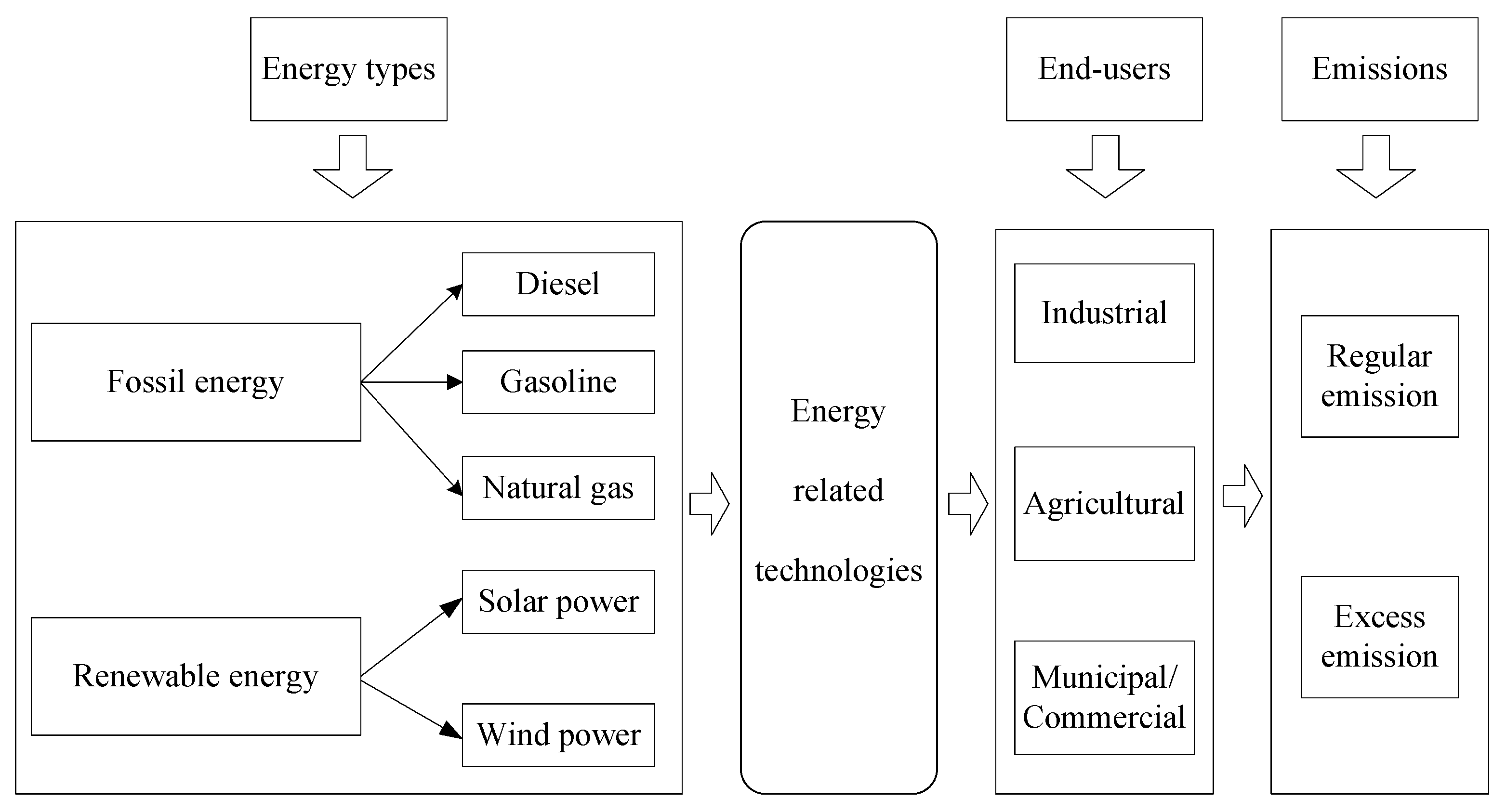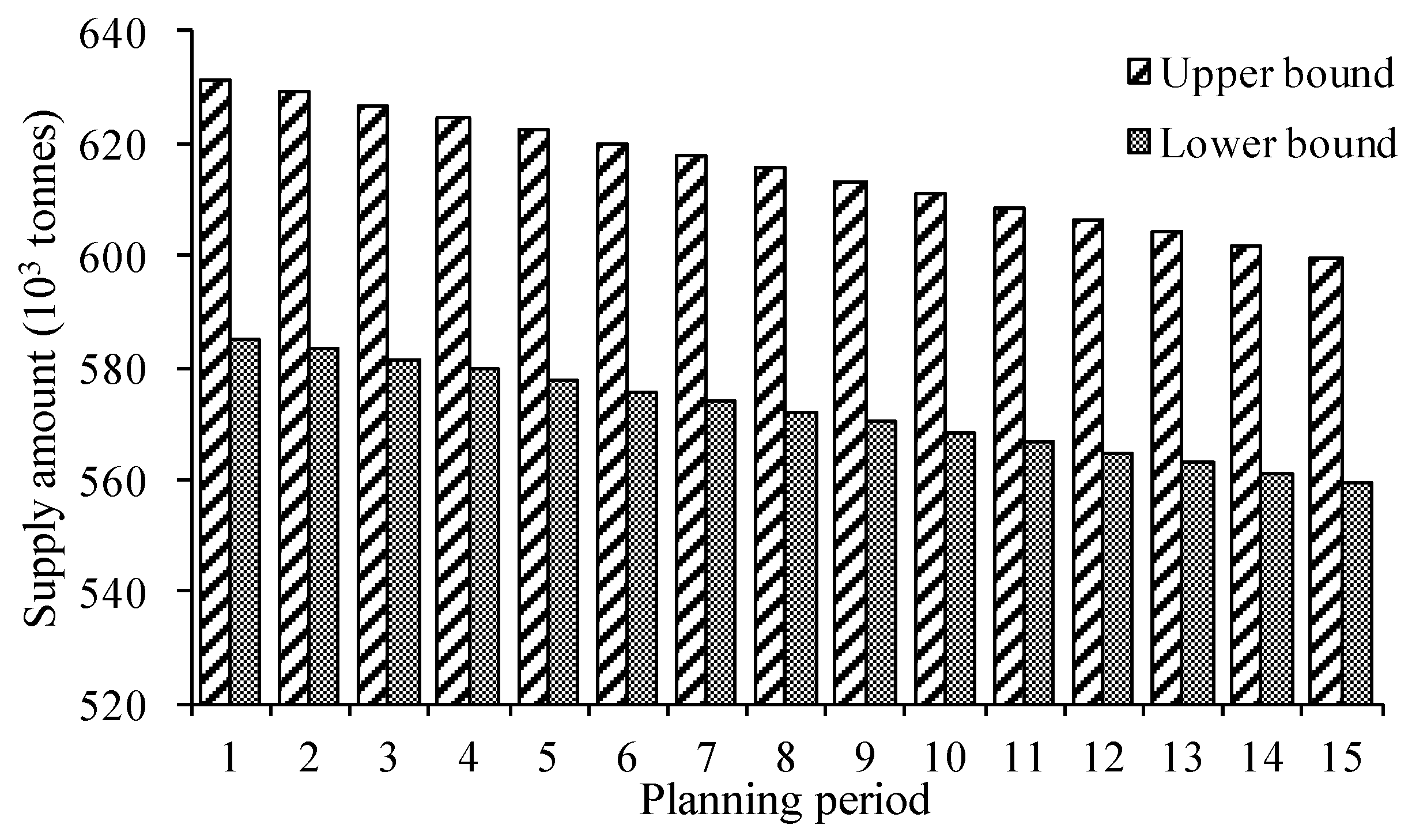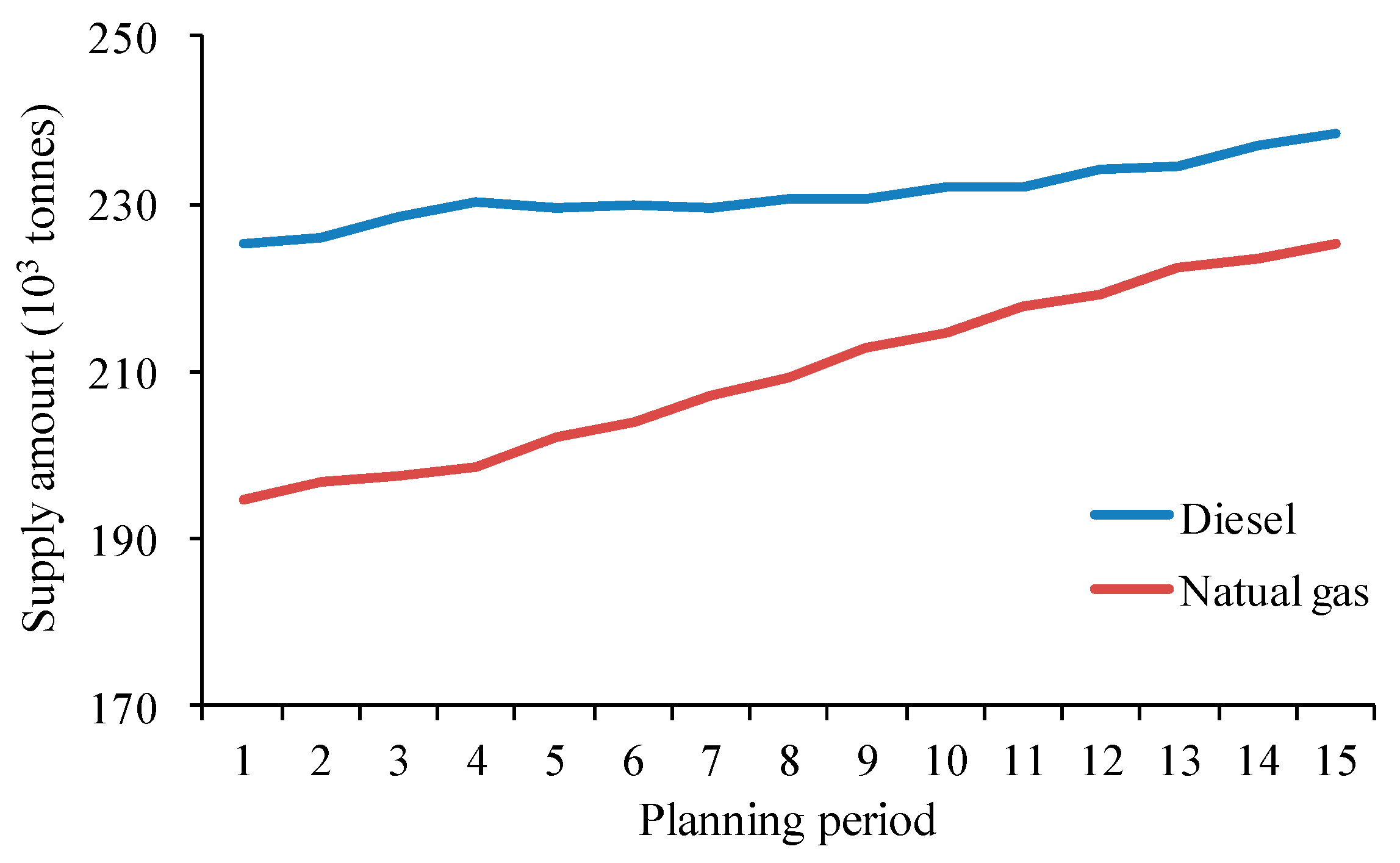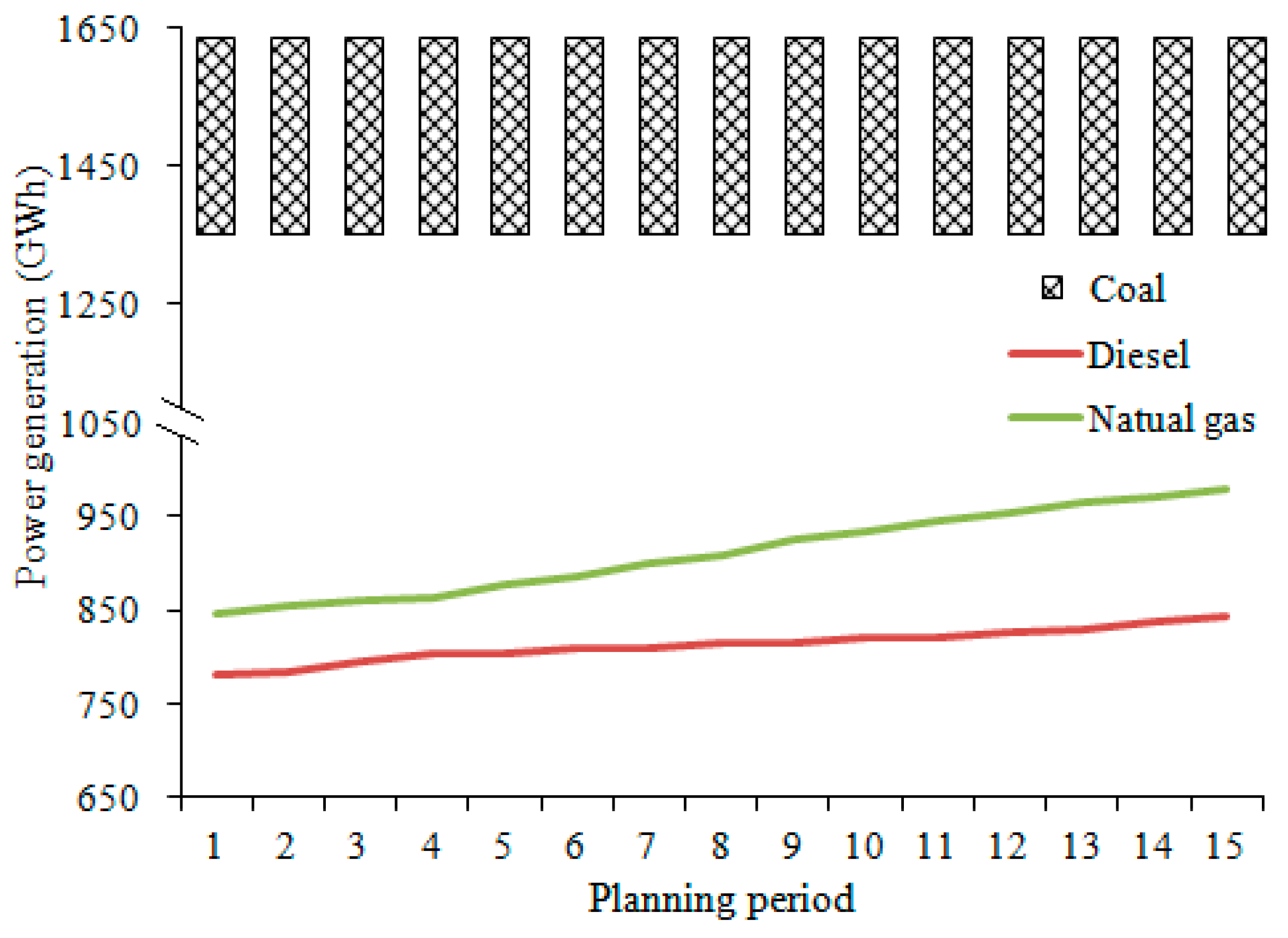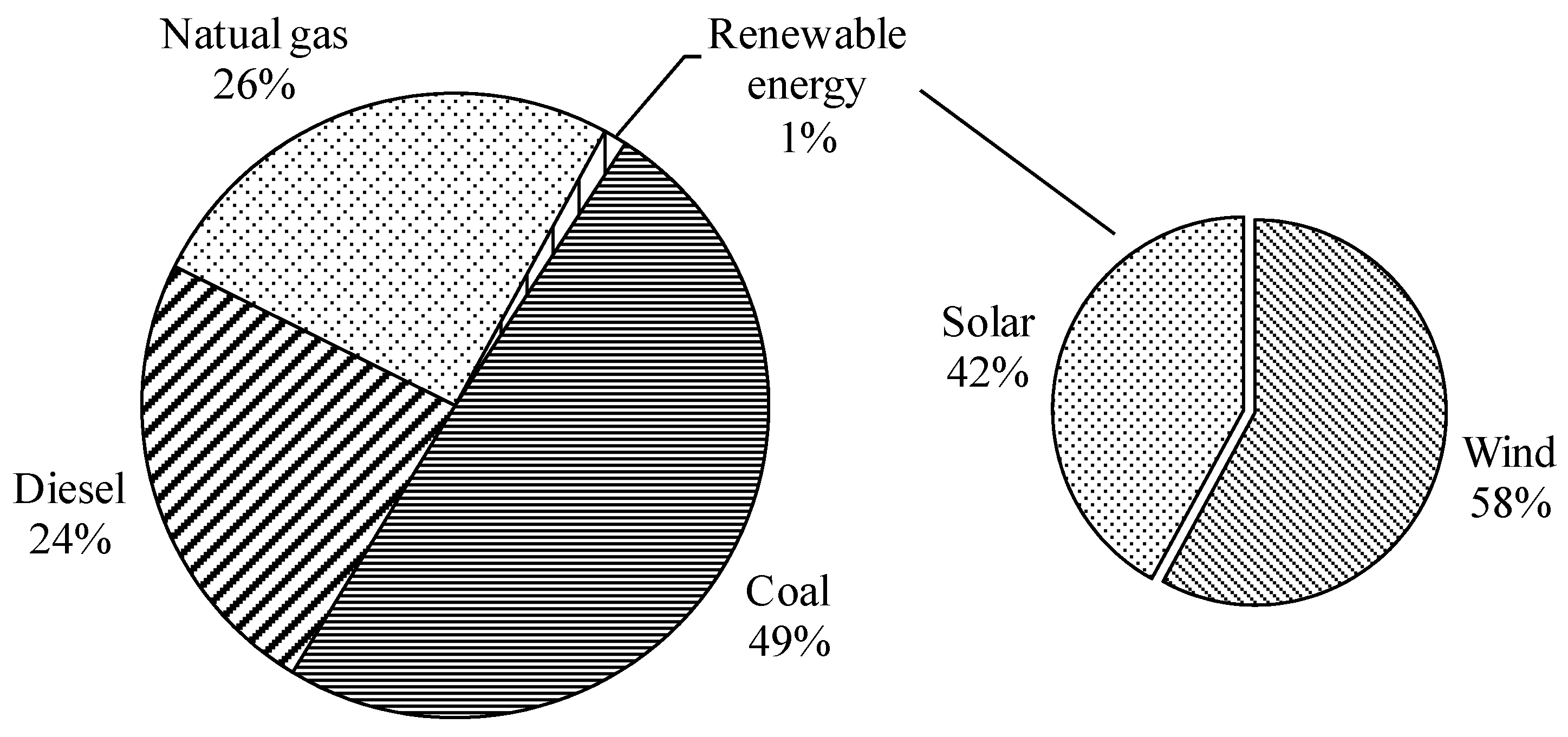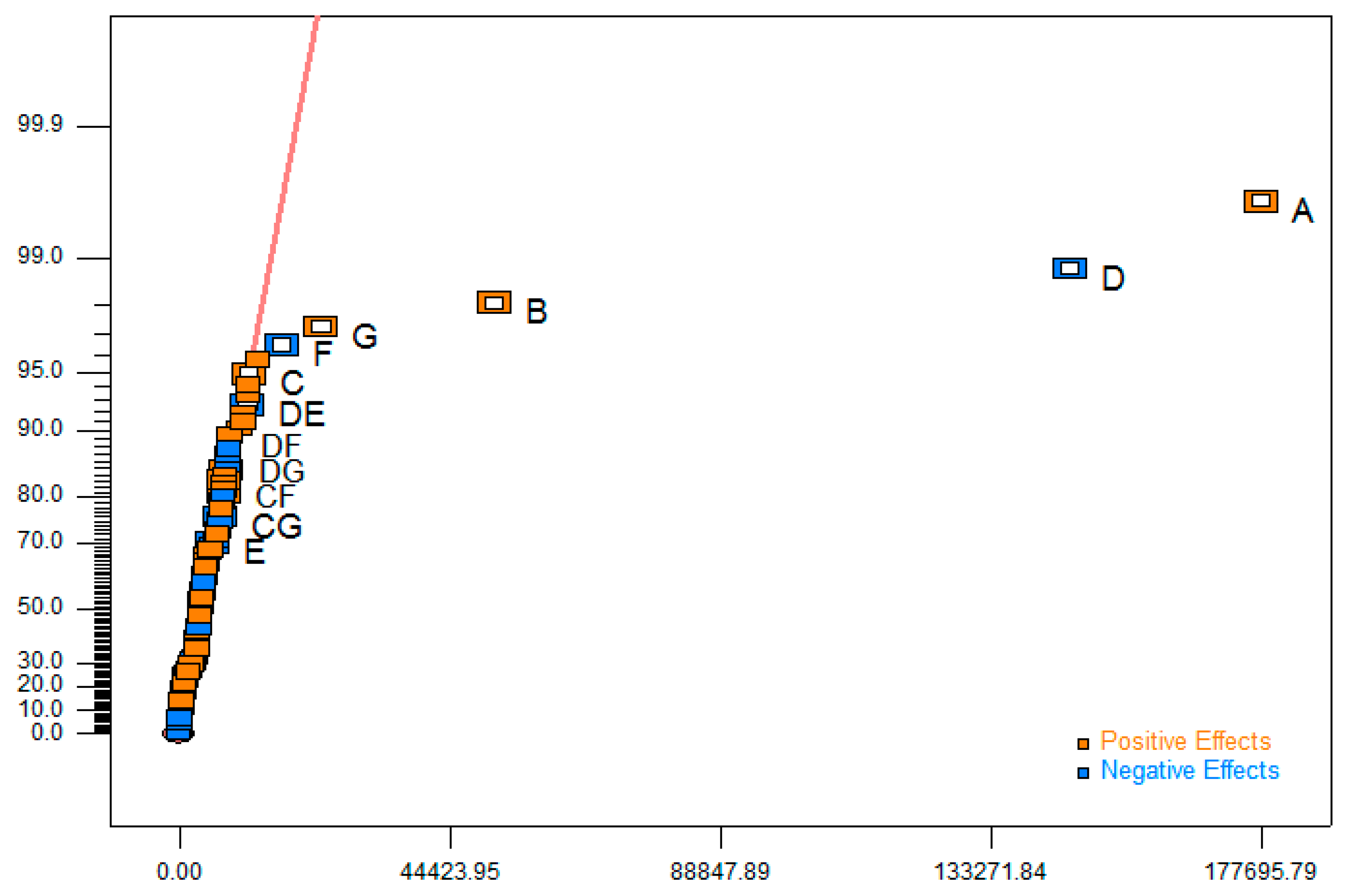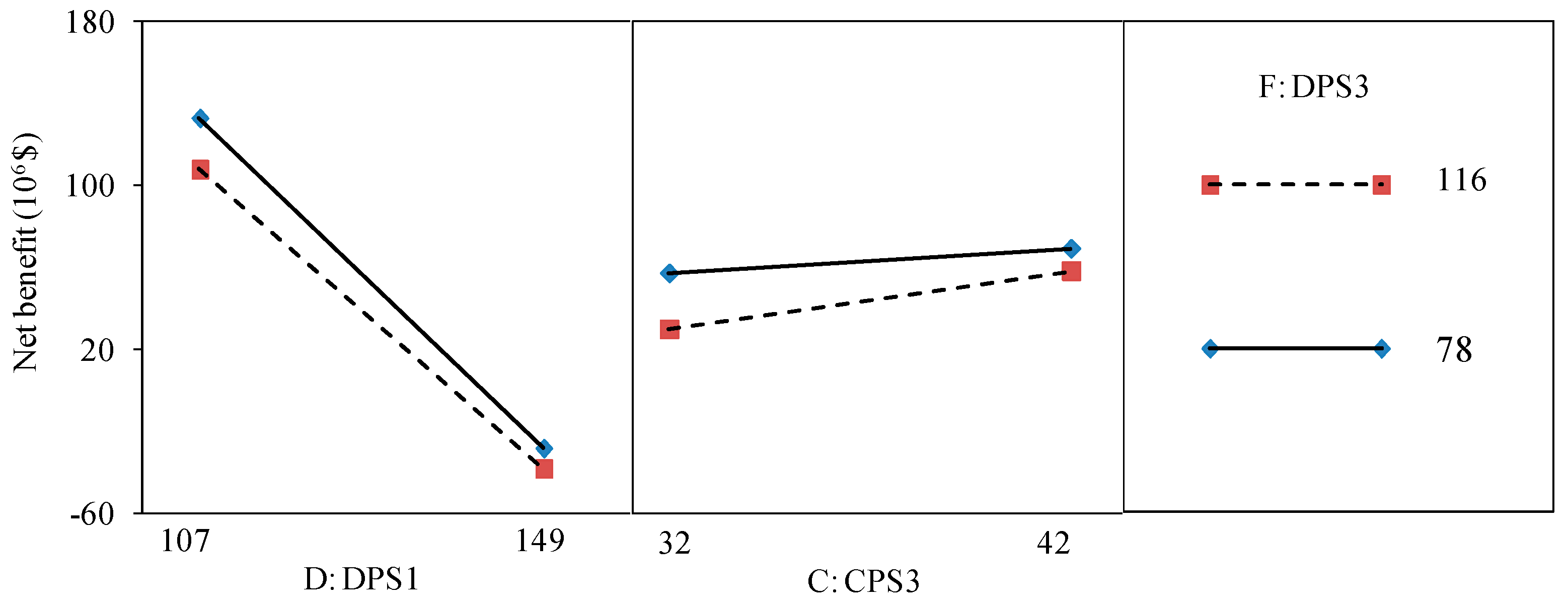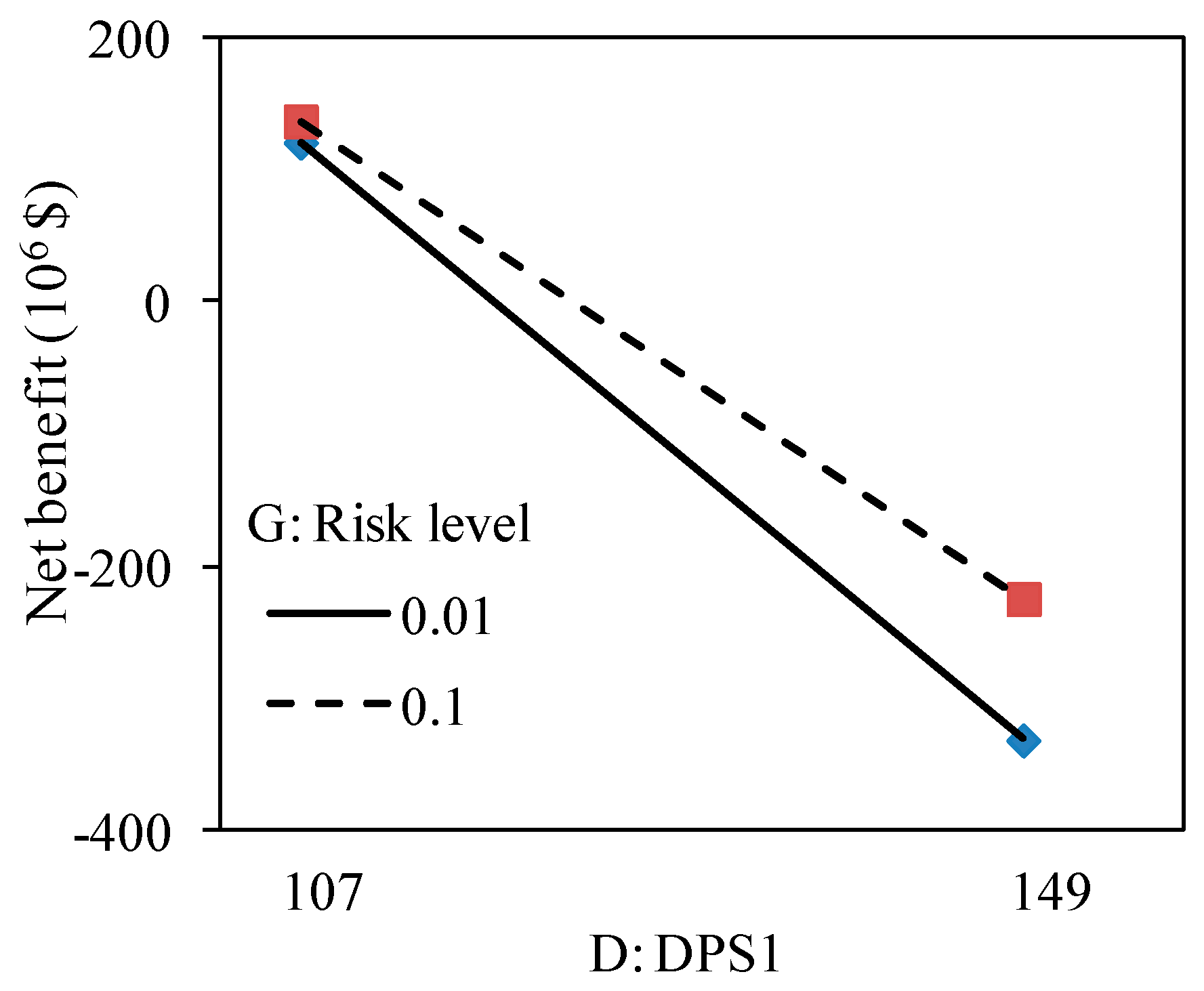3.1. Overview of the Study System
The renewable energy management system is intricate, and it consists of multiple factors such as economic, environmental and mechanical manners. The system is the combination of resource supply, power generation, capacity expansion and energy utilization process. And more importantly, those internal factors have definite connections with each other through transmission lines. Generally, primary energy supply resources include fossil fuels and renewable energy resources. Correspondingly, a variety of power generation technologies should be adopted in the energy management systems. Energy power generated should be allocated to meet the need of end users. Besides, according to the requirements of social and economic development, it is also very important to ensure all the facilities meet the environmental standard.
In this study, a hypothetical, but typical renewable energy management model is proposed for demonstrating the capability of the proposed optimization approach. The general structure of the proposed system is presented in
Figure 1. The data are summarized through government reports and related literature, typical cost, and representative technical data are provided. The system contains multiple energy sources and technologies. Particularly, coal, diesel and natural gas are selected as typical fossil energy, while wind power and solar power are chosen as representative renewable energy. Decision makers should develop an effective plan to satisfy the industrial, agricultural and municipal energy demands. Regarding the environmental aspect, the power generation process will cause an inevitable pollution emission. SO
2 is chosen as the representative emission. Based on historical data, a predefined pollution control target is stipulated to each power generation facility. If the promised target is achieved, the unit could obtain certain profits as the net benefit. However, if an excess emission occurs, an economic penalty will be charged.
This study aims to develop an optimization integrate sensitive analysis model for supporting the scientific management of energy system by effectively dealing with the following problems: (1) Various types of uncertainties existed in the provided system, it should be reflected accurately and resolved effectively; (2) An optimal solution of energy activities should be obtained to balance the tradeoff between economic and environmental benefit, as well as the system stability. The results should include energy generation plan, technology selection result, and capacity expansion scheme; (3) The environmental control process should be represented. The related environmental factors would restrict the application of energy resources and technologies. For example, with a stricter policy, energy with lower emission rate or higher generation efficiency will be recommended. Correspondingly, it will provoke increased system cost; (4) The key impact factors and their potential interaction should be revealed. It would provide more detailed information for future decision making.
3.2. Stochastic Factorial Energy Systems Management Model
Therefore, the objectives of the study system are: (1) Arrange the five power conversion technologies effectively to meet the energy demands while maximizing the system benefits under uncertainty; (2) determine the minimum energy supply amount; (3) coordinate energy activities and environmental standard. Through the proposed method, a stochastic factorial energy systmes management model can be formulated. The objective function of the SFESM model can be expressed as follows:
(1) System benefit related to environmental policy:
(2) Cost for power generation
(3) Purchasing cost for primary energy supply
(4) Cost for capacity expansion
The net benefit is to be maximized by a series of constraints. The impact factors and their interactions are also provided. The detailed constraints are expressed as follows:
(1) Mass balance
(energy supply should be more than resource consumption)
(2) Availability of energy resources
(energy usage should be less than its availability)
(3) Electricity constraints
(electricity generation should be more than energy demands)
(4) Capacity limit
(installed capacity should be more than electricity generation)
(5) Constrains for controlling contamination
(SO
2 emission should be less than environmental standard)
(Actual SO
2 emission should be less than emission control target)
(SO
2 generation amounts should be more than the excess amount, and less than given maximum)
The detailed nomenclatures for the variables and parameters are provided in the
Appendix A. The research target is to maximize the system benefit under uncertainty. The developed energy model can be solved through the above method by decomposed into two deterministic sub-models. Specifically, the two-stage problem can be solved by letting
, where
. According to the Formulas (14)–(16) in
Section 2.2, probability bounds of constraint violation under consideration are 1% and 10%. Transform the developed model into two sub-models, formulating the first sub-model which corresponds to
. Then
can be obtained through the solution. Similarly, formulating the second sub-model corresponding to
and substituted calculated value above. Combine the two sub-models’ solutions to obtain the optimal solution of the proposed model. The data of energy activities are provided in
Table 1. Pollution treatment targets and the related economic data are given in
Table 2.
Furthermore, the factorial technique is introduced to a sensitive analysis of factor impact for system objective. It is predetermined that if energy activities meet the environmental standards, the specific regulation would affect net benefit directly. Therefore, factors related to pollution emission would have a more obvious influence on the evaluation of the system. The factorial design would then be simplified. It is not necessary to examine all system variables, only the factors relevant to the contamination control process should be taken into account. It would reduce the complexity of sensitive analysis and retrench the operation time. By factorial analysis technique, the key impact factors could be revealed. Meanwhile, it could demonstrate their potential interaction effect, which may have a greater impact on the system than individual variable. It would provide more detailed information for decision maker than traditional energy management methods. Future planning should be paid more attention to the key factors such as formulating stricter environmental standard or greater penalties.
3.3. Result Analysis
In this study, fifteen planning periods are considered, and each representative for one year. Through solving the developed model, the optimal primary energy supply scheme, electricity generation plan and conceivable capacity expansion options were generated. Solutions of contamination control and excess emission amount were calculated under different risk levels. It can demonstrate a basic tendency of energy activities and provide potential suggestions for policy development.
Figure 2 presents the purchasing plan for coal at each planning period. The result shows that the allocation amount had a visible downtrend over time. The allocated amount would decrease from [585.2, 631.4] × 10
3 tonnes to [559.3, 599.7] × 10
3 tonnes, fell about 4~5% during the fifteen years. It is in conformity with the basic requirement of a popular total amount control policy for coal. On the other hand, it also reveals that coal would still be the major energy source in the near future for its splendid reserve, extensive distribution, and shallow embedding. It means the coal usage should be on a declining trend yet would be less obvious. The non-renewable energy resources are a major component of energy supply in most cases. In this study, diesel and natural gas would also be selected to provide power to the end users.
Figure 3 provides the energy supply pattern of diesel and natural gas. The diesel supply would increase from 225.3 to 238.4 × 10
3 tonnes during the planning period, while the deliverability of natural gas would increase from 194.8 to 225.4 × 10
3 tonnes. The growth rate would be 5.8% and 15.7% respectively. The total purchasing amount of diesel and natural gas would be nearly half of coal. The allocated amount for diesel would be relatively stable. However, there’s a significant increase in natural gas. The difference between these two energy sources would be diminished over the planning period. If the tendency persists, natural gas may take coal’s place as the most favorite fuel in just a few decades. In a practical environment, according to BP statistical review of world energy, the world’s energy structure begins to diversify. It trends to increase thermal power generation by natural gas and decrease oil usage. That indicated the proposed case study could reflect the general trend thus provide useful information for policy making.
With the economy development, electrical power demand would increase every year. On the one hand, coal-fired power is the key factor in electricity generation activities. The efficiency for oil-based generators is close to coal, while the efficiency for natural gas-based generators would be almost twice higher. On the other hand, when emission control is considered, gas may be at least 25% cleaner than coal. From the environmental aspect, natural gas would be the optimal sources for energy supply. However, the operating cost for gas generators is much higher. Thus, it’s important to find a balance between them.
Figure 4 presents the optimized solution of electricity generation plans of fossil energy. In detail, the energy generation by coal would be [1350.0, 1637.2] GWh over the planning horizon while the energy consumption would slightly decrease. Diesel and gas-fired power would be markedly increased. The electricity generated by diesel would range from 780.4 to 842.5 GWh. Gas based electricity would increase from 847.0 GWh to 979.9 GWh, and the median would be 900.7 GWh. The growth rate for gas-fired power would be 15.7%, while the growth for diesel was modest. In this study, renewable energy sources were also employed. In this study, renewable energy sources were also considered. The installed capacities for wind/solar power were set under 50 MW, since the large-scale applications of renewable energy are still not mature and the maintenance costs are much higher (
Table 1). The initially installed capacities for fossil energy were set to 300 MW. It turns out that contribution rate for renewable energy would be 1%. Among them, wind power would occupy 58%, while solar energy would be 42%. The results of power generation pattern are provided in
Figure 5 The result also shows that they could meet the demands of end-users; hence capacity expansion would not be needed.
Normally, a predefined SO
2 treatment target is promised to meet the environmental standards. If the commitment amounts are not delivered, due to the insufficient pollution control availabilities, excess emission will occur thus cause penalty for the system benefit. Under normal circumstances, the pre-regulated amounts will meet the demand. The higher probability is formulated for this case. However, some artificial subjective reasons like budgeting control or some uncontrollable factors, pollution treatment facilities are not effectively operated. It could affect pollution treatment availabilities. Therefore, a relatively lower probability is provided. In optimization studies, constraints could be partially satisfied. In order to obtain a more acceptable result, constraint violation may be allowed at certain risk levels. In this study, two risk levels were set to 0.01 and 0.1, respectively. Correspondingly, each represents the satisfaction degree for the constraints should be at least 99% or 90%. The detailed information is provided in
Table 3.
Solutions were generated for pollution control recommendations. As shown in
Table 4, optimized target treatment amounts were firstly obtained for three sources. The solutions of WS
iopt revealed that the optimal treatment targets would be 5.0 × 10
3 tonnes for SO
2 generated by the burning of coal, 2.8 × 10
3 tonnes for diesel-fired SO
2, and 180 tonnes for gas-fired SO
2, respectively. The existing SO
2 processing capacity could not meet requirements, excess emission occurred at both risk levels. For risk level at 0.01, when the availability is relatively low with a probability of 40%, excess emission for the three sources would be 5.0, 0.3 and 0.2 × 10
3 tonnes, respectively; when the availability is higher with a probability of 60%, excess SO
2 emission for coal and natural gas would be 1.9 and 0.2 × 10
3 tonnes, while no excess emission would occur for diesel-based power plant. For risk level at 0.1, the availability increases under this circumstance. Generally, with stricter environmental policies, excess emission would decrease. When at the lower probability, excess emission for diesel-fired plants would drop to 0.1 × 10
3 tonnes; while at the higher probability, excess emission for coal-based plants would drop to 1.7 × 10
3 tonnes. Other data would be unchanged at two risk levels. The results also indicate that when pollution treatment availability is insufficient, the SO
2 produced by diesel plants would be firstly treated, and secondly for coal-fired plants. This is because the penalty for diesel-fired pollution is the highest and the relevant units could also bring substantial benefit. For gas-fired plants, SO
2 discharge would not be controlled, since the total amount is quite small. The actual treated amount for each type of power plant at different risk levels can be calculated from treatment targets and excess emissions, all the results are also expressed in
Table 4.
To address uncertainties in a thorough manner and provide a comprehensive outcome, a further sensitive analysis is necessary. The object of the proposed system is to address the maximum net benefits while meeting the constraints. It is important to reveal the main factors related to the study objectives. Factorial analysis is therefore introduced to examine these uncertain parameters and their interactions. In this study, the system benefit is calculated based on emission production amount, while the penalty will be taken when violated the environmental policy. Thus, seven factors related to the pollution control process are selected. These factors are donated as A, B, C, D, E, F and G. All the factors are presented at two levels. For factors A: F, they refer to the lower and upper bound of the chosen variable, since they are all interval numbers. For factor G, they represent the two risk levels.
Table 5 shows all the selected uncertain parameters. The proposed two-level factorial design with seven factors would require 128 experimental runs. The major purpose of this design would be verifying and evaluating the factors influencing on total system benefits.
Figure 6 presents the half-normal plot of the effects of all the factors. The plot is an effective graphical technique to help identify the key factors. The larger the distance represents the more significant impact of the factor. The yellow outcome represents positive effects, which means increasing the net benefits. Correspondingly, the blue square representing penalty to the system. The results indicate that factors A, D, B and G would be the key effect factors. Besides, for some interaction factors, the effect is significant. For example, the effects for interaction DE, DF, DG, CF and CG are higher than the main effect of factor E. It implies that an important interrelationship may exist between the factors and their interaction plot should therefore be analyzed.
Figure 7 provides the interaction plot of factors D and E. It implies that the factor D would have a negative effect on the net benefit. When the value for factor D approach to its upper bound, the total revenue of the system will decrease gradually. This trend would become more prominent when factor E is at its higher bound.
Figure 8 presents the interactions plot matrix for factor C/D with F. It indicates that factor C would have a positive effect on the system, but the impact is unapparent. The impact of factor D would become more significant with F at the lower bound, while the impact of C would be more obvious when F at the upper bound. Similarly,
Figure 9 shows the interaction plot of factors D and G. It states that the impact of factor D would become more significant when G is at the lower level. The results show that system benefits would be improved with a higher violation risk. When the profits surpass the punishment, it would contribute significantly to excess emission. That indicates that policies regarding the environment will not be loosened in order to allow more profits to pass environmental examinations. It reveals the tradeoffs between conflicting economic development and environment protection. It is a very important responsibility for decision makers to protect the environment during economics developing.
To demonstrate the superiority of the proposed method, a compared result is obtained with a traditional deterministic method. The proposed energy management system contains multiple planning affairs and multiple risk levels, due to the space limitation, only electricity generation plans with risk level α = 0.1 is emphasized in
Table 6. The programming approach was solved by replacing the uncertain variables with their mid-point values. Differing from the proposed method, with various uncertain inputs, the application of deterministic programming can only provide a single response. In realistic energy system planning, an accurate value could hardly provide the guidance for decision makers. Similarly, by solving the maximum and minimum values of the uncertain parameters, solutions under best/worst scenarios can be obtained. It can be used for judging the capability of the system, but hardly establish a stable interval for policy or strategy. Besides, the further sensitive analysis could be employed, but solutions of the deterministic method cannot reveal the interaction effects among different factors. Thus, it hardly provides useful analysis for decision variables.
Generally, the above analysis indicates that solutions of the SFESM model can provide an effective relevance with pre-regulated energy policies and the related penalties. It facilitates the settlement of multiple types of uncertainties. Optimal primary energy supply, electricity generation, capacity expansion and pollution control plans are generated. The interval results under different risk levels are operable and can help decision makers obtain diversified decision alternatives. Besides, techniques of sensitive analysis can be applied for supporting the further adjustment of the optimization model and promoting the commonality to the practical situation.
